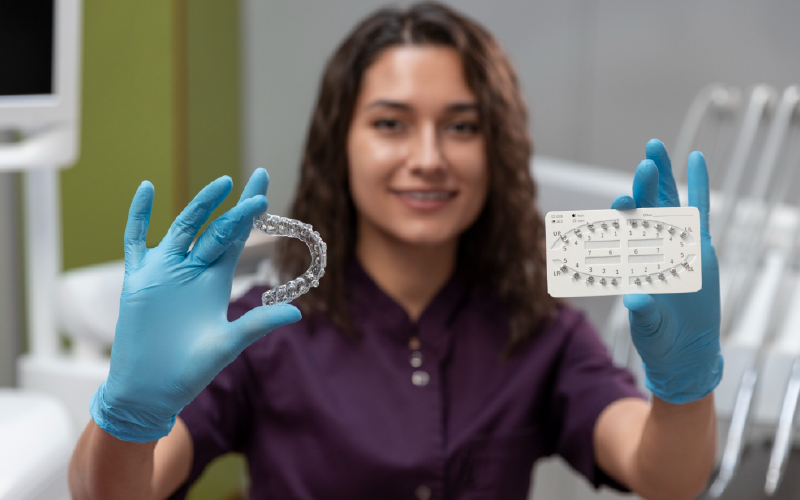In the world of orthodontic treatments, the quest for a perfect smile often leads to a pivotal decision: Invisalign or traditional braces? This choice is more than just about aesthetics; it’s about aligning with a treatment that meets your lifestyle, budget, and dental needs. So, let’s delve into the realms of aligners vs. braces, comparing their benefits and drawbacks to see which might be the better fit for you.
Understanding the Contenders

– Invisalign
A modern approach to straightening teeth involves wearing a series of custom-made, clear plastic aligners that gently shift your teeth into place.
The magic of Invisalign lies in its virtually invisible design and the flexibility it offers, making it a popular choice among adults and teens alike.
– Traditional Braces
On the other hand, they have been the cornerstone of orthodontics for decades. Comprising metal brackets attached to the teeth, connected by wires and tiny rubber bands, they are a testament to time-tested effectiveness.
With advancements in dental technology, clear braces have also emerged as a less noticeable alternative, albeit with a cost variation.
Braces vs. Invisalign
– Aesthetic Appeal
When it comes to which is better, Invisalign or braces, in terms of aesthetics, Invisalign often takes the lead. The clear aligners are barely noticeable, making them a preferred choice for those who are self-conscious about wearing braces.
Clear braces offer a compromise, being less visible than their metal counterparts but not as discreet as Invisalign.
– Effectiveness and Flexibility
Both treatments are effective in correcting a wide range of dental issues, from simple to complex alignments. But sometimes, more severe situations or particular kinds of adjustments are better suited for traditional braces.
Invisalign’s removable nature allows for easier eating and cleaning, granting a level of flexibility that braces can’t match. This means with Invisalign, you’re less restricted in your diet and can maintain oral hygiene more effectively.
– Treatment Duration and Commitment
The duration of treatment varies significantly depending on the individual’s needs.
Invisalign often promises shorter treatment times for mild to moderate cases, but this comes with a caveat: the success of Invisalign heavily relies on the wearer’s commitment to keeping the aligners on for the recommended 22 hours a day.
With braces, the control is in the hands of your orthodontist, making them a more foolproof solution for those who might struggle with the discipline required for Invisalign.
Also Read: Comfort and Convenience: Choosing an Orthodontist Who Meets Your Needs
Braces vs. Invisalign Cost

An important consideration when making decisions is cost. Generally, the braces vs. Invisalign cost debate doesn’t have a clear winner, as the price can vary widely based on the complexity of the case, geographical location, and duration of the treatment.
However, Invisalign tends to be slightly pricier due to the custom aligners and the technology involved. It’s important to consult with a dentist for all your dental needs to get a precise estimate for your specific situation.
How Does Invisalign Work?
Invisalign’s process involves a digital scan of your teeth, from which a series of aligners are custom-made to fit snugly over your teeth.
Your teeth are gradually moved towards their optimal positions with each set of aligners, which is worn for roughly two weeks before switching to the next in the series. Regular check-ups with your dentist ensure the treatment is progressing as planned.
– Clear Braces Cost
The cost of clear braces, as determined by a dentist in Simi Valley, can sometimes be higher than traditional metal braces due to the materials used and the aesthetic benefits they offer.
Like Invisalign, the cost will vary based on individual needs and treatment length. It’s vital to have a thorough consultation with your orthodontist to understand the financial commitment involved.
Conclusion
Deciding between Invisalign and traditional braces—or their clear counterparts—isn’t a one-size-fits-all answer, and consulting with a dentist can provide personalized insights.
It hinges on a multitude of factors, from the complexity of your dental issues to your lifestyle preferences and budget constraints.
Invisalign offers a blend of aesthetics and convenience, ideal for those seeking a discreet solution and willing to commit to the responsibility it demands. Traditional braces, celebrated for their reliability, are often favored for more complex dental corrections or for younger patients who may not adhere to the discipline Invisalign requires.
In navigating this decision, the support of a trusted provider of family dental care becomes crucial. They can offer personalized advice, based on a comprehensive evaluation of your dental health and alignment objectives.
Ultimately, whether you opt for Invisalign or traditional braces as part of your orthodontics treatment in Simi Valley, you’re embarking on a journey toward a healthier, more radiant smile.
